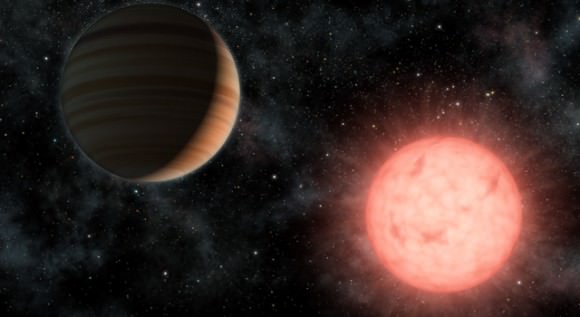This artist’s concept shows the smallest star known to host a planet. Image credit: NASA/JPL-Caltech
In May 2009, astronomers were jubilant: finally, an extra solar planet had been found by using the method of astrometry. That’s great, except, they may not have found a planet after all. Researchers from JPL reported they found a Jupiter-like planet around a star smaller than our sun. But follow-up observations of the star VB10 are coming up empty. “The planet is not there,” said Jacob Bean from the Georg-August University in Gottingen, Germany, who used a different and more successful approach to look for exoplanets, radial velocity.
Astrometry measures the side-to-side motion of a star on the sky to see whether any unseen bodies might be orbiting it. Using this method is difficult and requires very precise measurements over long periods of time. Using astrometry to look for exoplanets has been around for 50 years, but it hadn’t bagged a verified exoplanet – until, astronomers thought, earlier this year. A team of researchers announced an exoplanet, six times more massive than Jupiter, orbiting a star about one-thirteenth the mass of the Sun, using a telescope at the Palomar Observatory in southern California (S. Pravdo and S. Shaklan Astrophys. J. 700, 623–632; 2009).
“This method is optimal for finding solar-system configurations like ours that might harbor other Earths,” astronomer Steven Pravdo of JPL said in May. “We found a Jupiter-like planet at around the same relative place as our Jupiter, only around a much smaller star. It’s possible this star also has inner rocky planets. And since more than seven out of 10 stars are small like this one, this could mean planets are more common than we thought.”
But using different methods, other astronomers aren’t finding anything.
“We would definitely have seen a significant amount of variation in our data if [the planet] was there,” said Bean, quoted in the online Nature News. Bean has submitted a paper to the Astrophysical Journal.
Radial velocity, which has found most of the extrasolar planets so far, looks for shifts in the lines of a star’s absorption spectrum to track its motion towards and away from Earth, which would be caused by the influence of a planet.
Pravdo says that Bean and his colleagues “may be correct, but there is hyperbole in their rejection of our candidate planet.” Bean’s paper, for instance, only rules out the presence of any planet that is at least three times more massive than Jupiter, says Pravdo, adding that the work “limits certain orbits for possible planets but not all planets.”
Astronomers expect astrometry to work much better above the distorting effects of the atmosphere. Two space missions in the works — the European Space Agency’s GAIA, due to launch in 2012, and NASA’s proposed SIM-lite (Space Interferometry Mission) will use the technique to search for planets as small as Earth around Sun-like stars. Astrometry potentially can yield the mass of a planet, whereas radial velocity only puts a lower limit on it.
Bean admits that astronomers might one day find a planet around VB10 if they scrutinize the star long and hard enough.
Source: Nature News


“an exoplanet, six times more massive than Jupiter, orbiting a star about one-thirteenth the mass of the Sun, … at around the same relative place as our Jupiter…”
That would mean an orbital period several times that of Jupiter, right? (don’t remember how / too lazy to make the calculation – 13 times 15 yrs ??)
Plus, you need half an orbit to make a good radial velocity detection, or say, a significant portion of orbit to make a sloppy detection. But, 6 months???
Well, if there is no planet, there are bound to be false positives along the way. It’s amazing that we are able to detected any planets at all outside out solar system.
We’re now less than a month before the Kepler team is due to announced their first haul of planets. They will all be short period planets (hot Jupiters and their ilk) but it will be interesting to see how many they have turned up in the first few weeks of operation.
I have a question about this article. As I understand it, the radial velocity method detects motion to and from the observer. The astrometry method detects motion from side to side, perpendicular to the observer. If the plane of the exoplanets orbit were nearly perpendicular to the line of our observation, couldn’t that explain the results? In that case the only motion of the parent star would be from side to side in a tiny ellipse with no radial motion at all. Thanks.
The jovian planet and the star are close enough in mass so one can use the reduced mass
mu = Mm/(M + m)
Then use Newton’s second law with gravity to get
mu f^2R = GMm/R^2
and so the frequency of the motion f is
f^2 = G(M + m)/R^3,
which is one of Kepler’s laws. Now one can use the numbers above to compute the freqency of the motion. As a rought guide use the frequency of Jupiter 1/11.8yr and then find the period of this system with respect to Jupiter. I get a frequency f ~ .024/yr, or an orbital period of 42.5 years. That is pretty slow.
LC
I would also like to point out that if spelling “Gottingen” with an English keyboard, it should really be spelt “Goettingen”, or if you’re feeling particularly German, then “Göttingen”.
Also, if you’re using an English keyboard, the XML/HTML character code for the “O” with the umlaut are (without the underscores): &_ouml_; (lower-case); &_Ouml_; (upper-case).